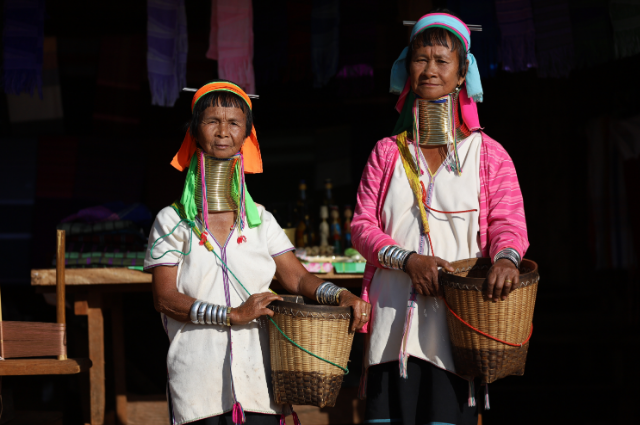
All humans are prototypically tribal by nature. The concept of ‘tribalism’ accelerates the social inclusion of all members of the indigenous species in a globally free society. Tribes are the cluster of pre-literate people who live in relative isolation in a specific territorial outskirt region in the lap of Mother Nature quite far from the cruel claws of urbanization. Tribes are the immediate children of Nature, the primitive earthen souls of ancient civilizations. They are connected with the ‘Dame Nature’ by maternal affection. Nature’s viridescent nourishment nurtures their unique naturalist ideologies, cultures, practices, and creativities that enrich the heritage of India, and justify the significance of ‘unity in variety’ at its apex.
India is impregnated with 705 ethnic groups officially that are recognized as ‘Scheduled Tribes’, however, a large number of indigenous groups are still left unrecognized. The tribes from the Northern region of India generally belong to Indo-Aryan or Mongoloid origins. The major tribes of Himachal Pradesh are the Kinnaura, Gujjar, Lahaule, and Gaddi whose general habitations are cattle rearing, wool raising, cultivation, and horticulture. According to the myth, the Kinnaura tribe belongs to the Kinner group of heaven, mentioned in Mahabharata for their mastery of fine arts and music. Gujjar tribe adopted the Islam custom; therefore their dialects, cultures, costumes, and practices are the living documents to showcase the inter-cultural amalgamation. Lahule tribe follows Buddhism as they are the omnium gatherum of the genes of Munda and Tibetan people.
In the Western region of India, 6 million Adivasis, the various tribes are found in the terrain of the Aravalli range. Siddhi, Rabari, Padhar, and Bharwad tribes are the aborigines of the coastal area of Junagadh and Kutch. Siddhi tribe has features similar to the Negroids as they migrated from East Africa whereas the Australoid tribes named Voknas, Varlis, and Gambits are found in the river valleys of the Bulsar region with Konkan features, and Bhil Garasias, Dungri Bhils, Naikas are lived in the hilly region close to the eastern border. These tribes endorse the prestigious rights of women in their community and respect the free spirit of women to convey their opinions as well as likings.
The largest assemblage of the indigenous group is found in the ‘seven-sister-states’, the North-East region of India. The Angami, Ao, Konyak, Lotha, and Sumi are the predominant tribal origins of Nagaland. They have their distinctive indigenous tradition, music, culture, heritage, festivities, customs, foods, apparel, jewelry, and languages originating from the Sino-Tibetan language group. In Ziro Valley, Arunachal Pradesh, the nose plugs, face piercing, and face tattoos of the Apatani tribe women left the fashion world awestruck! These are not incorporated to enhance beauty but rather to decrease it, as it may prevent the forceful abduction of Apatani women by others that usually happened in the primitive era.
In the Southern region of India the Gowda, Kunbi, and Dhangra are the chief tribes that are located in the coastal area of Goa. They also adopted European influences during the period of colonization in India. There is also a much-discussed nomad tribe who is found in Andaman Island. Jarawa, the ‘forest tribe’, who is in love with ‘primitivism’ rather than the false glamour of ‘civilizations’.
India is adorned by the ‘central tribal belt’ that has wrapped around ‘Her’ as a waist-brace from Rajasthan to West Bengal. Tribes named Bhil, Munda, Baiga, Santhal, Birhor, Korku, Pahari Korwa, Abhuj Maria, Bison Horn Maria, Gond, and Kamar, are the aborigines of that ‘central tribal belt’. One of the largest tribes that are found in Chattisgarh, Madhya Pradesh, Maharashtra, and Rajasthan is the Bhil tribe. Bhil derived from the word ‘billu’ or bow. Bhils are known to be excellent archers and traditional herbalists. In the Bastar region, the Bison Horn Maria tribe is the main attraction for their unique headgear made from the skeleton of the now-extinct wild Bison, worn during their festivals.
Santhals are the most musical and literature-enriched tribe in India. A torpid tipsiness grows with the profound reverberation of the meter generated from the tamak and tumdak; the essential musical instruments of Santals. The honeyed tune of bamboo-made ‘tirio’ flute, the heart-wrenching struck on of ‘dhodro banam’ and the harmonious dance-around steps going hand-on-hand are the obvious picturesque of the festivities of Santhal tribes who are found across Jharkhand, Chhattisgarh, Bihar, West Bengal, Assam, and Orissa.
India has an abundance of colorful tribal cultures, apparel, music, livelihoods, and practices, but within this distinctiveness, a correlative quotient always remains at its core their feelings of unity. Each Indian tribe possesses a cohesive attitude to retain their identity, a self-sufficient attitude towards livelihood, endogamous nature to preserve their authenticity in blood, and above all the hue of simplicity that adds the seasoning at its top.
Sources:
- tribalFaces.pdf
- Tribes in India_208_Reading (igntu.ac.in)
- https://fotorbit.com
- https://www.survivalinternational.org
- https://asoulwindow.com
- https://indiantribalheritage.org
- https://indiantribalheritage.org
